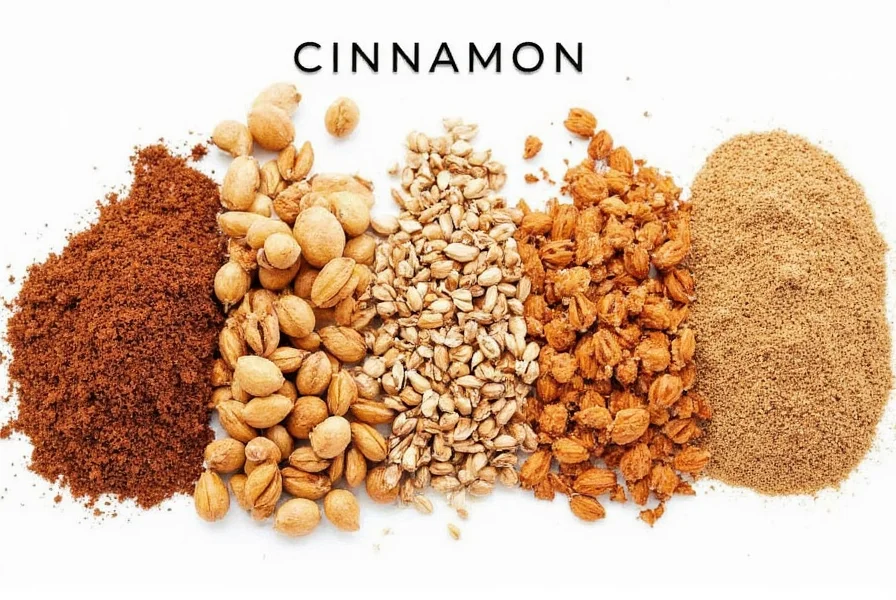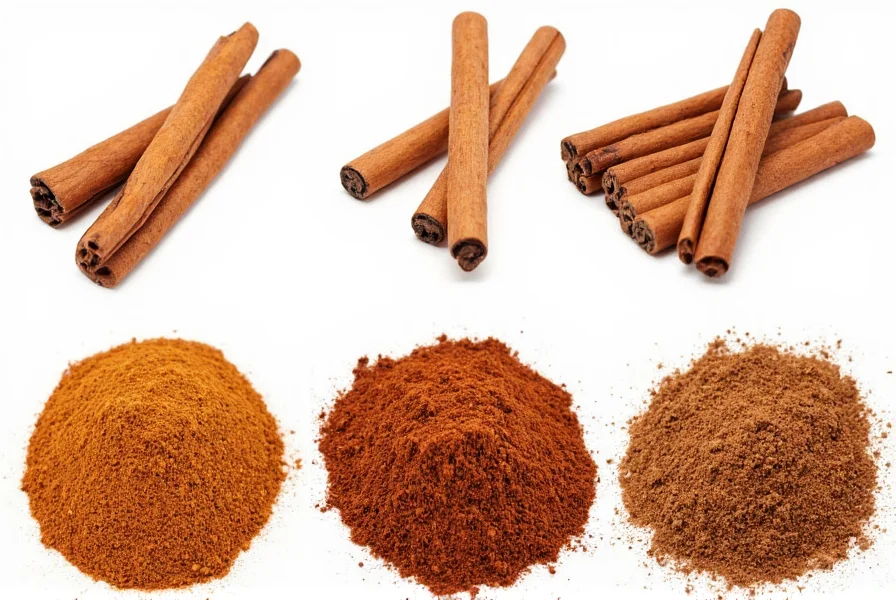The four primary cinnamon varieties are Ceylon ("true cinnamon"), Cassia (Chinese cinnamon), Saigon (Vietnamese cinnamon), and Korintje (Indonesian cinnamon). Ceylon has delicate, layered bark with a subtle sweet flavor and low coumarin content, while Cassia varieties feature thicker, harder bark with stronger, spicier notes and higher coumarin levels. Understanding these differences is essential for both culinary applications and health considerations.
When exploring cinnamon varieties for baking and cooking, it's crucial to understand how each type impacts flavor profiles and potential health effects. Cinnamon isn't a single uniform spice but rather several distinct botanical varieties that vary significantly in chemical composition, flavor intensity, and culinary applications. This comprehensive guide examines the key characteristics that differentiate the major cinnamon types available globally.
Understanding the Four Main Cinnamon Varieties
Cinnamon comes from the inner bark of trees in the Cinnamomum genus, but not all "cinnamon" is created equal. The marketplace confusion between different cinnamon types often leads to unexpected results in recipes and potential health implications due to varying coumarin content.
Ceylon Cinnamon: The True Cinnamon
Native to Sri Lanka (formerly Ceylon), Cinnamomum verum represents what many consider "true cinnamon." This variety features multiple delicate, paper-thin layers that form a tight, hollow tube. When compared to common cinnamon varieties in grocery stores, Ceylon stands out with its lighter brown color, softer texture, and complex flavor profile featuring citrus and floral notes alongside the familiar cinnamon warmth.
Nutritionally, Ceylon cinnamon contains significantly lower levels of coumarin (approximately 0.017g per kg) compared to Cassia varieties. This makes it the preferred choice for those consuming cinnamon regularly or in larger quantities, as high coumarin intake may affect liver health. Despite its superior safety profile, Ceylon typically commands a higher price due to more labor-intensive harvesting methods and lower global production.

Cassia Cinnamon: The Most Common Variety
When you purchase "cinnamon" at most supermarkets, you're likely getting Cassia (Cinnamomum cassia), which accounts for approximately 90% of cinnamon sold in the United States. Originating in China, this variety features a single thick, hard bark layer that forms a dense, robust quill. Cassia delivers a stronger, more intense flavor with pronounced spiciness and less complexity than Ceylon.
The higher coumarin content in Cassia (ranging from 2.1-4.4g per kg) necessitates moderation in consumption, particularly for individuals with liver conditions or those using cinnamon supplements. Despite these considerations, Cassia remains popular for its bold flavor in spice-heavy applications like cinnamon rolls and holiday baking where its robust character shines.
Saigon and Korintje: Cassia Subtypes with Distinct Profiles
Saigon cinnamon (Cinnamomum loureiroi) from Vietnam represents a particularly potent Cassia subtype with the highest essential oil content (approximately 3.5%) among commercial varieties. Its intense, sweet-spicy flavor makes it ideal for applications where cinnamon should dominate, such as in cinnamon sugar or spiced beverages.
Korintje cinnamon, primarily from Indonesia, offers a middle ground between Ceylon's delicacy and Saigon's intensity. With moderate coumarin levels and a balanced flavor profile, it serves as a versatile option for everyday cooking. When evaluating different cinnamon varieties for specific recipes, Korintje often provides the best compromise between flavor impact and safety for regular use.
| Variety | Origin | Coumarin Content | Flavor Profile | Best Culinary Uses |
|---|---|---|---|---|
| Ceylon | Sri Lanka | Very Low (0.017g/kg) | Delicate, sweet, citrus notes | Desserts, beverages, delicate sauces |
| Cassia | China | High (2.1-4.4g/kg) | Strong, spicy, robust | Baking, spice blends, hearty dishes |
| Saigon | Vietnam | Very High | Intensely sweet-spicy | Cinnamon rolls, spiced drinks, bold recipes |
| Korintje | Indonesia | Moderate | Balanced, warm | Everyday cooking, general purpose |
How to Identify Cinnamon Varieties
Distinguishing between cinnamon varieties by appearance requires attention to several key characteristics. Ceylon cinnamon forms multiple thin layers that resemble a cigar when rolled, creating a soft, crumbly texture that's easy to grind. Cassia varieties form a single thick layer that creates a dense, hard quill resistant to breaking. The color difference is notable too—Ceylon appears light tan to medium brown, while Cassia ranges from reddish-brown to dark brown.
When purchasing ground cinnamon, identification becomes more challenging. Look for labeling that specifies "Ceylon" or "Cinnamomum verum" for true cinnamon. Many specialty spice retailers now clearly distinguish between varieties, recognizing growing consumer awareness about cinnamon varieties health considerations.
Practical Substitution Guide for Recipes
Understanding how different cinnamon varieties affect recipes helps prevent disappointing results. When substituting Ceylon for Cassia, use approximately 1.5 times the amount called for, as Ceylon's flavor is more delicate. Conversely, when using Cassia in place of Ceylon, reduce the quantity by about one-third to avoid overpowering other flavors.
For health-conscious consumers, particularly those using cinnamon supplements or consuming it daily, Ceylon represents the safer option due to minimal coumarin content. Those with liver conditions should consult healthcare providers about appropriate cinnamon consumption levels based on variety.
Storage Recommendations for Maximum Freshness
To preserve the volatile oils that provide cinnamon's distinctive aroma and flavor, store both quills and ground cinnamon in airtight containers away from light and heat. Whole quills maintain freshness significantly longer than ground spice—up to 3-4 years versus 6-12 months for ground cinnamon. For best practices with different cinnamon varieties, consider grinding small quantities of whole quills as needed for optimal flavor impact in sensitive applications.
Common Misconceptions About Cinnamon Varieties
Many believe all cinnamon offers identical health benefits, but research shows significant differences in antioxidant profiles and bioactive compounds between varieties. While both types contain cinnamaldehyde (the compound responsible for cinnamon's characteristic flavor), their additional phytochemical compositions vary considerably.
Another misconception suggests Cassia is "fake" cinnamon, but all varieties are authentic—just different species. The designation "true cinnamon" for Ceylon refers to historical usage rather than superiority, though its lower coumarin content does provide a safety advantage for regular consumption.
Conclusion: Selecting the Right Cinnamon for Your Needs
Understanding the distinctions among cinnamon varieties and their culinary applications empowers better cooking and informed health decisions. For everyday use where cinnamon plays a supporting role, Korintje offers excellent value and balanced flavor. When creating delicate desserts or consuming cinnamon regularly for potential health benefits, Ceylon provides superior safety and nuanced flavor. For bold applications like cinnamon rolls or spiced chai, Saigon's intense profile delivers maximum impact. By recognizing these differences, home cooks and professional chefs alike can make more informed choices that enhance both flavor and wellbeing.
Frequently Asked Questions
Which cinnamon variety has the lowest coumarin content?
Ceylon cinnamon (Cinnamomum verum) contains significantly lower coumarin levels (approximately 0.017g per kg) compared to Cassia varieties (2.1-4.4g per kg). This makes Ceylon the preferred choice for regular consumption, especially for individuals with liver conditions or those using cinnamon supplements.
Can I substitute Ceylon cinnamon for regular cinnamon in recipes?
Yes, but you'll need to adjust quantities. Ceylon cinnamon has a more delicate flavor, so use about 1.5 times the amount called for when substituting for Cassia varieties. For recipes where cinnamon should be prominent (like cinnamon rolls), you may want to stick with Cassia or Saigon cinnamon for stronger flavor impact.
How can I tell the difference between Ceylon and Cassia cinnamon?
Ceylon cinnamon forms multiple thin, delicate layers that create a soft, crumbly quill, while Cassia forms a single thick, hard layer. Ceylon appears light tan to medium brown and has a sweeter, more complex flavor with citrus notes. Cassia is darker reddish-brown with a stronger, spicier flavor profile. When in doubt, check product labeling for "Ceylon" or "Cinnamomum verum" specifications.
Which cinnamon variety is best for baking?
The best cinnamon for baking depends on the recipe. Saigon cinnamon works well for bold applications like cinnamon rolls due to its high essential oil content (3.5%). For more delicate baked goods like apple pie or custards, Ceylon's subtle flavor won't overpower other ingredients. Korintje offers a versatile middle ground for everyday baking needs with its balanced flavor profile.
Does the cinnamon variety affect blood sugar management?
Research suggests both Ceylon and Cassia cinnamon may support blood sugar management, but Cassia contains higher levels of potentially beneficial compounds. However, Cassia's higher coumarin content requires consumption moderation. For regular use aimed at blood sugar support, many health professionals recommend Ceylon due to its safety profile, though slightly larger quantities may be needed to achieve similar effects.











 浙公网安备
33010002000092号
浙公网安备
33010002000092号 浙B2-20120091-4
浙B2-20120091-4